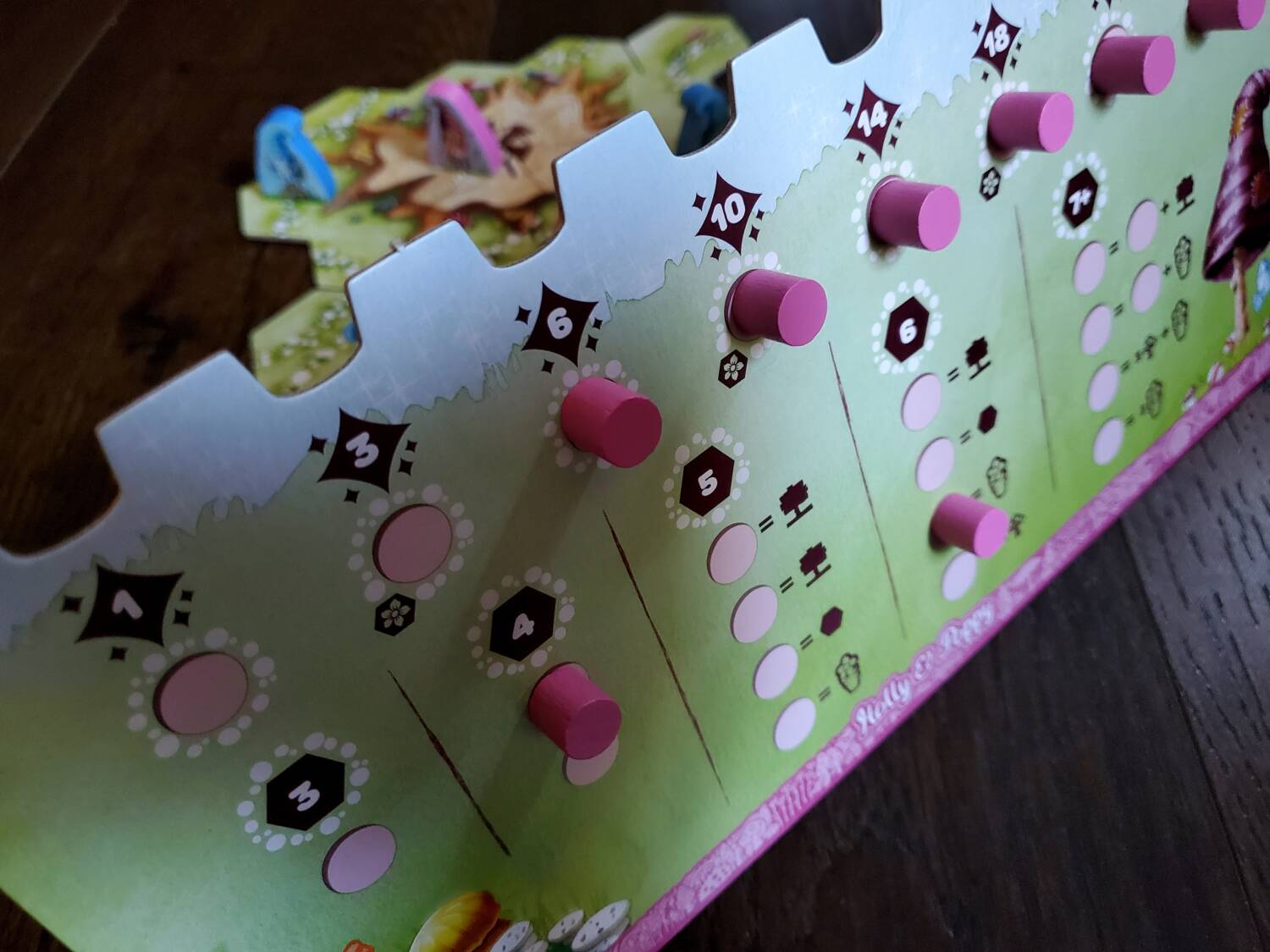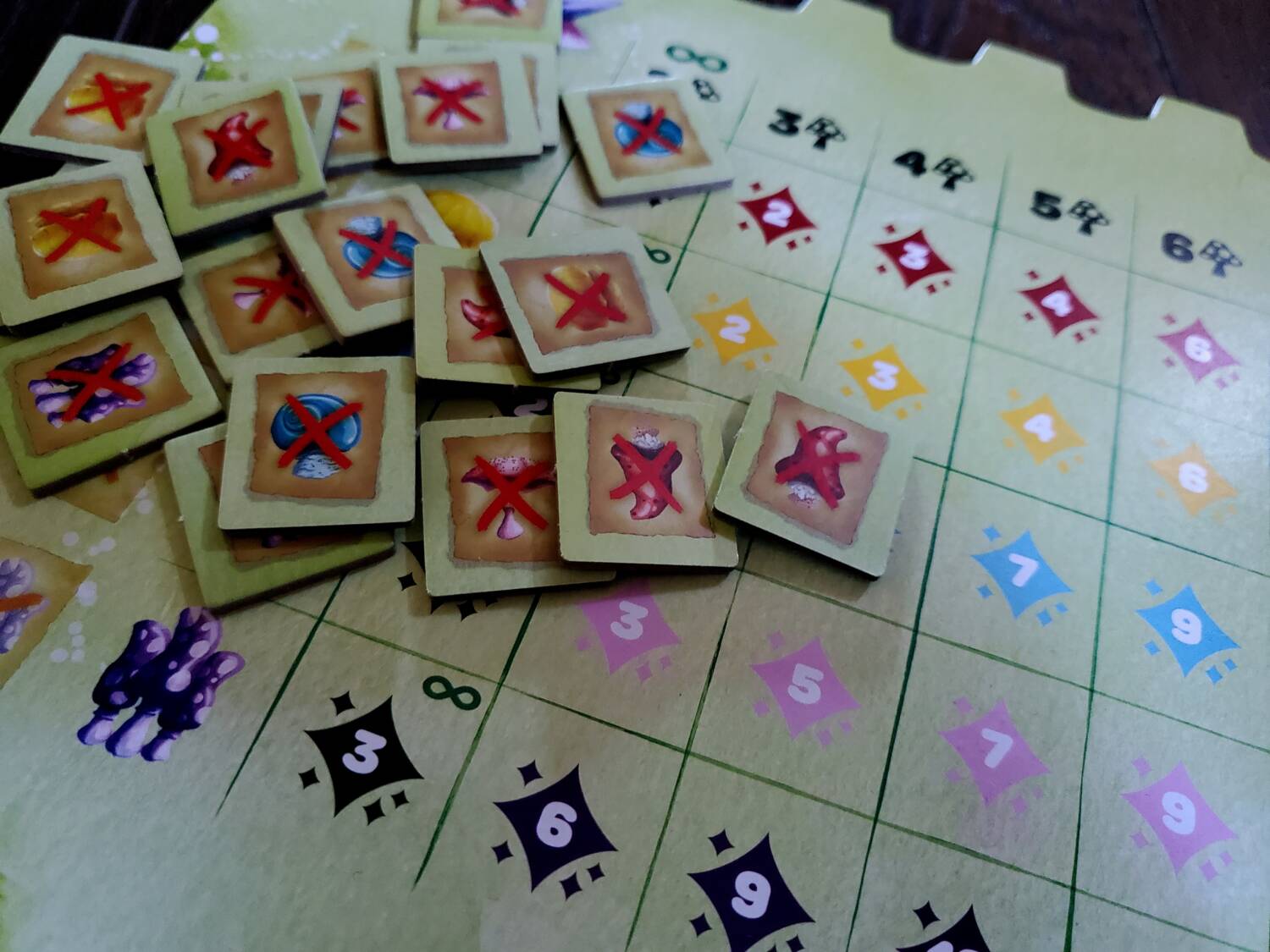Disclosure: Meeple Mountain received a free copy of this product in exchange for an honest, unbiased review. This review is not intended to be an endorsement.
Looking at the box, I fully expected Gnome Hollow to be cute—the sort of cute that leads a publisher to take the Gen Con balloon sculpture by the horns and make it all gnome-y. I can’t say I expected it to be as substantial a game, though. As it turns out, there’s a lot going on in there. Sometimes you even lift back the pointy hat to find competitive little thieves behind the rosy cheeks and beards.
Gnomenclature
The path to describing the gameplay of Gnome Hollow is not entirely linear. Every turn is a flow chart complete with if/then statements and cascading consequences (not unlike Mr. Lynch’s flowing review of Riftforce). A relatively simple, cartoony, flowchart by comparison, but a chart nonetheless.
Players add two (or more) hex tiles to the central garden to begin each turn. Tiles are predominantly green with some combination of glittery path and colorful mushroom(s). The great hope is to enclose a glittery path ring to unleash a series of fortunate events. The first is to (potentially) collect every mushroom depicted on the path. The second is to (likely) move a ring marker on the player board from its starting location to a bonus spot—determined by the number of tiles incorporated in the ring—and to receive any subsequent cascading bonuses.

Of course, the only way to gain mushroom tokens from a completed ring is to place a gnome on the ring or, ideally, have one there already. Gnome, you say? Each player controls two wooden gnomes that move around the expanding garden unleashing actions after the tile placement is through. Actions include claiming a ring (helpful in gathering the aforementioned mushrooms), trading the mushrooms for treasures (victory point tokens), claiming a pot of flowers, or engaging a signpost.
Flowers, you say? As players move certain ring tokens on their player boards, various stacks of flowerpots are stocked into a market. The aim is to gather one pot of as many different colored flowers as possible. The player who unlocks/stocks the various flowers receives a wild tile for use in the central garden that proves mighty helpful in a jam. And signposts? One of the bonuses involves adding signposts to completed rings that become extra functional locations for the gnomes to visit. By the game’s end, two or three gnome hot spots become eight or nine.

And did I mention that adding a tile to a ring claimed by another player requires permission from that player? A clever touch that almost never comes into play except in the employment of the more convoluted tiles, but one I appreciate nonetheless.
So place tiles (with permission as needed), move the ring marker (unleashing attached bonuses as far as need be), collect mushrooms (if the gnomes align), and move one gnome (to gobble mushrooms, unload mushrooms via competitive and single-use transactions, acquire flowers, or activate those signposts). It’s a flighty and occasionally distracted explanation that requires attention, but it’s sensible once you take up residence inside the mental garden chart. Super simple scoring, thank goodness, makes it easy to keep all eyes on relatively few ultimate prizes.
Gnome sayin’?
Evaluating the physical product is a jumble of cheers and jeers. The ring markers are magnetic, which means no matter how you bump your player board, the little bits stay where you left them. Awesome—we felt like we’d suddenly seen the invention of fire, or the dis-invention of the dual-layered player board. Now if only it was cost effective to magnetize those hex tiles to hold the garden in place while the gnomes roam!!

I mentioned the single-use transactions. The system is laid out as an easy-to-read grid, X number of purple mushrooms scores Y points—first come, first serve. As a game design, this adds a lovely tension to treasure collection. In the least sensible product design choice, though, the markers are printed as color specific where a simple X, or a red chit, or a disc, or best yet a glass bead would have been easier, 100% less frustrating to set up, and beautiful. I would replace these in a heartbeat for $2 at the local craft shop, because sorting and stacking color-specific tokens at the beginning is unnecessarily annoying.

Despite gnomes being little things, their Hollow sure takes up a lot of space. The garden grows, forcing most of the shared market spaces, mushroom piles, treasure piles, signposts, flowers, etc. to sprawl out of someone’s reach by the midway point of play. The gnomes themselves, as they say, don’t share, but players will have to learn to help one another out to pass the fungals and trinkets around.
Otherwise, this thing is cute. The gnomes are charming, the signposts are definitely cool, the artwork is inviting. The insert is well laid out and the rulebook contains a lot of narrative elements. I worry that the drawstring bag will unravel eventually, but it’s a great size and matches the aesthetic of the game. Gnome Hollow mostly delivers on its aesthetic promise.
Gno mercy?
Most sessions of Gnome Hollow followed a similar trajectory. Whether your interest is mushrooms, flowers, or massive rings, you will enter another decision matrix to maximize your intended accomplishments. Most of the time folks have one gnome protecting a ring while the other runs errands all over the garden. But there comes a point in every game where folks start finishing unprotected rings (leaving the mushroom booty) just to move ring markers and push the game towards its end. I enjoy the tension of the late game far more than the slow build of the beginning. I think the game’s opening chapter would benefit from a semi-random bag draw, two-tile placement with a single gnome already on guard as part of the setup. As they say, if the first turn (or two or three) is always the same, make it part of the setup.
My favorite design choices here are the required tile placement and the single gnome movement. Late in the game, there will come a point where you really don’t want to help anyone else by starting or extending a ring, but you also don’t have the gnome-power to protect what you lay. This tile-required tension is then solidified by the fact that you can only move one gnome per turn. As the bag of tiles dwindles or a neighbor nears their complete set of flowers, you just can’t do it all and build effective rings. Gnome Hollow shines brightest in forcing a potentially unwanted thing while limiting the wanted thing.
When someone leaves a partial ring, though, the gardening gloves come off. There’s a bit of necessary nasty in the competition here that results from the fact that you can’t protect everything. Maybe it’s because the gnomes are s’darn cute, but we found ourselves apologizing as we swiped opportunities, mushrooms, and bonuses from each other. If the game is to reach its full potential, you really have to seize these moments.

Gno matter what…
Our six-year-old was able to play with little difficulty, but the flowchart-y aspect was difficult for the little ones to track. They’d collect, move the ring token, move a gnome and sell mushrooms before I’d look at the market and ask, “Did you even place a second tile?” Their excitement bred a bit of chaos in evaluating what they ought to be doing, and in what order. That said, they took to the grand scheme with ease, even if it required a bit of accounting on my part. There’s no doubting the family charm here, as long as someone pays attention.
The adult-folk were mostly surprised by the amount of game going on and felt the designed tensions a bit more acutely. The little buggers are an experience. The backside of the player boards has an advanced variant that presents exact tile configurations to unlock bonuses, a nice added touch. If you’re into tile-laying, especially with that ring-creation, worker placement generating effect, you’ll probably dig what these little creatures are up to. Whether you’re into playing it nice or undercutting the gnome next door, you’ll probably find the game suits your play style.
There are a few little quirks that keep the rating from truly excelling. Cardboard wasted, continual variable accounting, constant reaching, and the somewhat predictable first chapter are among the chief offenders. Gnome Hollow isn’t perfect—not by a longshot. The table of adults were all smiles, but it’s stronger as a family play. The kids loved it and were instantly asking to try it again. I think The Op has put together a box with a lot to celebrate.











